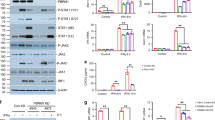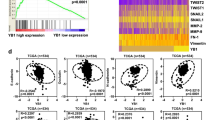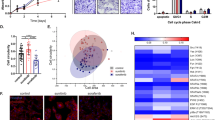Abstract
In renal cell carcinomas (RCC), NF-κB blockade is required for maximal bortezomib-induced apoptosis, and expression of the von Hippel-Lindau (VHL) tumor suppressor protein downregulates NF-κB. Thus, we hypothesized that expression of wild-type (wt) VHL sensitizes RCC cells to bortezomib by reducing constitutive NF-κB activity. Using isogenic paired cell lines with and without expression of wtVHL, we have confirmed that VHL expression reduces constitutive NF-κB activity. Moreover, VHL expression confers markedly heightened sensitivity to the growth inhibitory effects of bortezomib in vitro. The bortezomib IC50 values were greater than two logs lower in the VHL-expressing cell lines compared to the VHL-deficient counterparts. By manipulating the level of constitutive NF-κB activity in an isogenic pair of RCC cell lines independently of VHL expression, we were able to demonstrate that the VHL sensitization effect is due to downregulation of NF-κB activity. These findings offer the enticing possibility of using VHL status as a molecular marker to identify RCC patients who may be sensitive to bortezomib. In particular, RCC patients who have non-clear-cell histologies as well as approximately 25% of clear-cell RCCs manifest expression of wtVHL and represent a subpopulation of patients that is apt to respond to bortezomib.
This is a preview of subscription content, access via your institution
Access options
Subscribe to this journal
Receive 50 print issues and online access
$259.00 per year
only $5.18 per issue
Buy this article
- Purchase on Springer Link
- Instant access to full article PDF
Prices may be subject to local taxes which are calculated during checkout





Similar content being viewed by others
References
Adams J, Palombella VJ, Sausville EA, Johnson J, Destree A, Lazarus DD, Maas J, Pien CS, Prakash S and Elliott PJ . (1999). Cancer Res., 59, 2615–2622.
An J, Sun Y, Fisher M and Rettig MB . (2004). Mol. Cancer Ther., 3, 727–736.
An J, Sun YP, Adams J, Fisher M, Belldegrun A and Rettig MB . (2003). Clin. Cancer Res., 9, 4537–4545.
Atkins MB, George D and Jonasch E . (2004). Up To Date.Rose BD (ed). Wellesley, MA.
Baldwin Jr AS . (2001). J. Clin. Invest., 107, 3–6.
Chen F, Kishida T, Duh FM, Renbaum P, Orcutt ML, Schmidt L and Zbar B . (1995). Cancer Res., 55, 4804–4807.
Cusack Jr JC, Liu R, Houston M, Abendroth K, Elliott PJ, Adams J and Baldwin Jr AS . (2001). Cancer Res., 61, 3535–3540.
Davis NB, Taber DA, Ansari RH, Ryan CW, George C, Vokes EE, Vogelzang NJ and Stadler WM . (2004). J. Clin. Oncol., 22, 115–119.
de Paulsen N, Brychzy A, Fournier MC, Klausner RD, Gnarra JR, Pause A and Lee S . (2001). Proc. Natl. Acad. Sci. USA, 98, 1387–1392.
Frankel A, Man S, Elliott P, Adams J and Kerbel RS . (2000). Clin. Cancer Res., 6, 3719–3728.
Glaspy JA . (2002). Semin. Oncol., 29, 41–46.
Gnarra JR, Zhou S, Merrill MJ, Wagner JR, Krumm A, Papavassiliou E, Oldfield EH, Klausner RD and Linehan WM . (1996). Proc. Natl. Acad. Sci. USA, 93, 10589–10594.
Godley P and Kim SW . (2002). Curr. Opin. Oncol., 14, 280–285.
Gunaratnam L, Morley M, Franovic A, de Paulsen N, Mekhail K, Parolin DA, Nakamura E, Lorimer IA and Lee S . (2003). J. Biol. Chem., 278, 44966–44974.
Hideshima T, Mitsiades C, Akiyama M, Hayashi T, Chauhan D, Richardson P, Schlossman R, Podar K, Munshi NC, Mitsiades N and Anderson KC . (2003). Blood, 101, 1530–1534.
Hideshima T, Richardson P, Chauhan D, Palombella VJ, Elliott PJ, Adams J and Anderson KC . (2001). Cancer Res., 61, 3071–3076.
Iliopoulos O, Kibel A, Gray S and Kaelin Jr WG . (1995). Nat. Med., 1, 822–826.
Jemal A, Thomas A, Murray T and Thun M . (2002). CA Cancer J. Clin., 52, 23–47.
Jorissen RN, Walker F, Pouliot N, Garrett TP, Ward CW and Burgess AW . (2003). Exp. Cell Res., 284, 31–53.
Mitchell BS . (2003). N. Engl. J. Med., 348, 2597–2598.
Nathan PD and Eisen TG . (2002). Lancet Oncol., 3, 89–96.
Oya M, Ohtsubo M, Takayanagi A, Tachibana M, Shimizu N and Murai M . (2001). Oncogene, 20, 3888–3896.
Pavlovich CP, Schmidt LS and Phillips JL . (2003). Urol. Clin. N. Am., 30, 437–454, vii.
Qi H and Ohh M . (2003). Cancer Res., 63, 7076–7080.
Richardson PG, Barlogie B, Berenson J, Singhal S, Jagannath S, Irwin D, Rajkumar SV, Srkalovic G, Alsina M, Alexanian R, Siegel D, Orlowski RZ, Kuter D, Limentani SA, Lee S, Hideshima T, Esseltine DL, Kauffman M, Adams J, Schenkein DP and Anderson KC . (2003). N. Engl. J. Med., 348, 2609–2617.
Author information
Authors and Affiliations
Corresponding author
Additional information
Supplementary Information accompanies the paper on Oncogene website (http://www.nature.com/onc)
Supplementary information
Rights and permissions
About this article
Cite this article
An, J., Fisher, M. & Rettig, M. VHL expression in renal cell carcinoma sensitizes to bortezomib (PS-341) through an NF-κB-dependent mechanism. Oncogene 24, 1563–1570 (2005). https://doi.org/10.1038/sj.onc.1208348
Received:
Revised:
Accepted:
Published:
Issue Date:
DOI: https://doi.org/10.1038/sj.onc.1208348
Keywords
This article is cited by
-
Panels of mRNAs and miRNAs for decoding molecular mechanisms of Renal Cell Carcinoma (RCC) subtypes utilizing Artificial Intelligence approaches
Scientific Reports (2022)
-
The HIF and other quandaries in VHL disease
Oncogene (2018)
-
VHL, the story of a tumour suppressor gene
Nature Reviews Cancer (2015)
-
HIF-1α-Dependent Gene Expression Program During the Nucleic Acid-Triggered Antiviral Innate Immune Responses
Molecules and Cells (2009)



